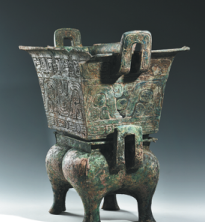Excavation unearths glimpse of ancient life
Updated: 2021-12-31

One of the bronze containers discovered at the Beibai'e archaeological excavation site. [Photo by Guo Yanjie for China Daily]
An archaeological excavation site in Shanxi was once again included in the top 10 archaeological discoveries with media influence rated by China Central Television on Dec 20.
The site, which is located in the village of Beibai'e in Yuanqu county, was given the award for the second time after it was included on the same list last year, because of its new findings this year.
Excavation of the site, which was identified as a group of tombs belonging to noble families between the Western Zhou Dynasty (c.11th century-771 BC) and Spring and Autumn Period (770-476 BC), began in April 2020 after damage caused by tomb robbing was reported in the area.
"The excavation was a salvage action taken by local archaeologists, aiming to protect the historical relics from any further damage caused by tomb robbers," said Yang Jiyun, head of the archaeological team at the Beibai'e excavation site.
"Since 2020, we have excavated relics from nine tombs and 17 caves, including more than 500 items ranging from bronze ware, stoneware, earthenware, jade articles, lacquer ware and bone artifacts," Yang said. "Ceremonial bronze ware pieces, which were numbered more than 140, accounted for the largest portion of the discoveries."
The archaeologist said the most significant discoveries were the nearly 50 pieces of bronze ware with inscribed characters.
"From the inscriptions, we can identify the exact family names and even full names of those buried in the tombs," Yang said. "And these were also records about the social lives and historical events of their times."
While the excavation is still underway, tourists are offered an opportunity to see these precious historical heritage relics. More than 100 items have been displayed at the Shanxi Archaeological Museum in the provincial capital of Taiyuan.
At a dedicated hall in the museum, two exhibits-a bronze pot and a bronze box-have attracted the attention of most of the visitors, as these have been proven to be the containers of wine and cosmetics made nearly 3,000 years ago.
"When we discovered remains of red powders and liquid residue in the two containers, we immediately asked the nation's top archaeological researchers to make analysis," said Nan Puheng, a researcher at the Shanxi Archaeological Research Institution. "The analysis results showed that the remains are a kind of fruit wine and makeup powder made from cinnabar, grease and flora essential oils."
Nan said the discoveries of the remains are of great significance as they can give people an idea of what life looked like nearly three millennia ago.
Guo Yanjie contributed to this story.



